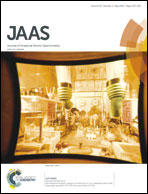Salt saturated single drop microextraction of gold from water samples and its determination by graphite furnace atomic absorption spectrometry
Abstract
A new microextraction procedure, termed salt saturated single drop microextraction, combined with graphite furnace atomic absorption spectrometry (GFAAS) was introduced and developed for the determination of gold in water samples. This is the first report of the extraction of a cationic species by direct immersion SDME utilizing a polar solvent. A mixture of benzyl alcohol–isopropyl alcohol was used as the extracting solvent from the brine sample, which can be considered as a form of salting-out solvent extraction. The factors influencing the extraction efficiency, such as type and volume of extracting solvent, extraction time, pH, agitation of sample, temperature and volume of sample were investigated and optimized. The developed protocol was found to yield a linear calibration curve in the concentration range of 25 and 550 μg L−1 with a limit of detection of 7.4 μg L−1. The total analysis time including microextraction was less than 10 min. The method has been successfully applied for the analysis of gold in three spiked tap, lake and seawater samples.


 Please wait while we load your content...
Please wait while we load your content...